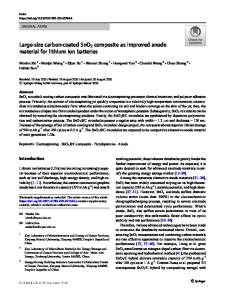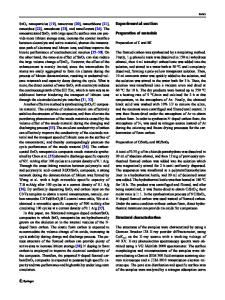Self-supporting and 3D MoS 2 /MoO 2 /CNT/graphene foam as high-performance anode for lithium ion batteries
- PDF / 1,143,863 Bytes
- 10 Pages / 595.276 x 790.866 pts Page_size
- 4 Downloads / 376 Views
ORIGINAL PAPER
Self-supporting and 3D MoS2/MoO2/CNT/graphene foam as high-performance anode for lithium ion batteries Jing Li 1 & Shaolin Du 1 & Huachao Tao 1,2 & Xuelin Yang 1,2 Received: 9 June 2020 / Revised: 12 October 2020 / Accepted: 18 October 2020 # Springer-Verlag GmbH Germany, part of Springer Nature 2020
Abstract Three-dimensional (3D) MoS2/MoO2/carbon nanotube/graphene (MS/MO/CNT/G) foam has been prepared through hydrothermal reaction and freeze-drying process. The ratio of MoS2 to MoO2 can be controlled by changing pH of solvent during hydrothermal process. The electrochemical performance of MS/MO/CNT/G foam can be optimized through changing the ratio of MoS2 to MoO2. Graphene oxide (GO) and carbon nanotube (CNT) as carbon source are employed to build a three-dimensional foam. MoO2 enhances electronic conductivity and MoS2 provides high capacity. The flexible foam can be directly used as a selfsupporting anode for lithium ion batteries. 3D MS/MO/CNT/G foam after the optimizing process exhibits high reversible capacity of 640 mAh g−1 at 100 mA g−1 after 200 cycles and 360 mAh g−1 at 1 A g−1 after 300 cycles when the pH was adjusted to 6. Keywords MoS2/MoO2/CNT/graphene . Free-standing anode . Lithium ion batteries . 3D foam
Introduction Lithium ion batteries (LIBs), due to their high energy density, long cycle life, and low cost, have been successfully adopted as energy sources for a wide range of portable electronic devices [1, 2]. LIBs are also used in energy storage equipment for electric vehicles and hybrid electric vehicles [3, 4]. It is well known that commercial LIBs usually use graphite as anode. However, the low theoretical specific capacity of graphite (372 mAh g−1) can hardly meet people's demand for LIBs with high energy density [5–7]. High specific capacity and working voltage of the electrodes can ensure high energy density for LIBs. In the past decades, enormous efforts have been made to improve the capacity and stability of LIBs,
* Huachao Tao [email protected] * Xuelin Yang [email protected] 1
College of Materials and Chemical Engineering, Key Laboratory of Inorganic Nonmetallic Crystalline and Energy Conversion Materials, China Three Gorges University, 8 Daxue Road, Yichang 443002, Hubei, People’s Republic of China
2
Collaborative Innovation Center for Microgrid of New Energy, Yichang 443002, Hubei, People’s Republic of China
and some non-graphitic materials with high specific capacity have also been employed. In this regard, various metal oxides (e.g., SnO2, TiO2, SiOx, and MoO2) [8–11] and metal sulfides (e.g., MoS2, SnS, FeS, and CoS2) [12–15] have been widely investigated in the light of their large theoretical capacities and low cost. Among these metal oxides and sulfides, Mo-based materials (MoO2 and MoS2) are considered to be the promising candidates for efficient LIBs due to their distinctive physical and chemical properties [16–19]. Molybdenum disulfide (MoS2) with a layered structure has a high theoretical capacity of 670 mAh g−1 for LIBs, which is higher than c
Data Loading...











